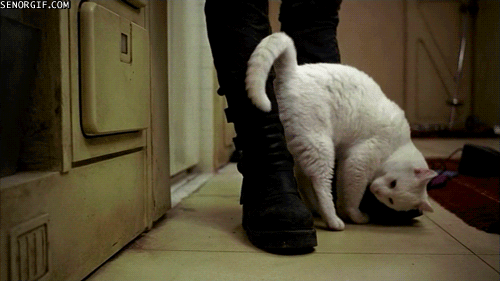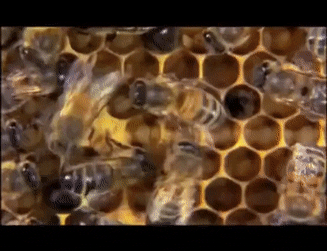你好!
我们家的猫目前没有这种行为,但是我记得它们很小的时候是有这种行为的,因为我有不小心被绊倒的记忆(黑线)……现在没有可能是因为体型变大了不方便,它们现在采取得更多的行为是轻轻蹭我的腿侧或者在我面前叫唤。

所以猫的这种行为应该是有普遍共性的,它的主要目的肯定有留下气味,但这可能并非是最主要的目的,猫「通过留气味的方式来操纵人类以获取自己需要的资源」,才是真正的目的。知乎曾有篇科普描述了这种行为:
对猫蹭腿这一行为有描述的研究还是不少的:
所以,猫用这种要命的方式,并不只是为了标记你,还是为了引起你的注意,从中得到好处。

行为学上把猫咪旋绕/摩蹭人类的这一行为, 统称为社交型触觉寻求行为 (Social Tactile-Seeking Behavior),这一行为目的在于引起人类的社交互动,如抚摸、玩耍和奖赏。许多研究如Vitale Shreve和Udell(2015)、Schötz(2019)都观察到这一行为与人猫互动密切相关,表达了猫咪对触觉刺激的需求,是猫咪主动寻求人类注意和互动的一种手段。Bradshaw等(2000)提出,这一行为源自猫咪作为一个社会物种对其领地内其他社会伙伴的互动需求。家养环境下, 人类取代了其他猫咪,成为这一需求的对象。
这种行为与蜜蜂的8字舞(waggle dance)有什么联系呢?

有,但不是很大。
蜜蜂的8字舞蹈(waggle dance)是一种象征性的交流行为。当蜜蜂在蜂巢内进行这种舞蹈时,它会传达食物源的方位和质量信息给其他蜜蜂,这使得整个蜂群能够迅速且高效地采集食物。所以这两个行为都起源于一种社交互动需要,但不同的是猫是为了寻求人类注意和互动,蜜蜂是为了传达信息。

Bradshaw, J. W., Casey, R. A., & Brown, S. L. (2000). The behaviour of the domestic cat. CABI.
Vitale Shreve, K. R., & Udell, M. A. (2015). What's inside your cat's head? A review of cat (Felis catus) cognition and cognition testing. Animal Cognition, 18(4), 823-833.
Stanton LA, Sullivan MS, Fazio JM. A standardized ethogram for the felidae: A tool for behavioral researchers. Applied Animal Behaviour Science. 2015 Jan 1;163:3-16.
Schötz, S. (2019). Play behavior in cats—A review. Journal of Feline Medicine and Surgery, 21(1), 53-60.
McComb, K., Taylor, A. M., Wilson, C., & Charlton, B. D. (2009). The cry embedded within the purr. Current Biology, 19(13), R507-R508.
Jensen, P. (2007). The ethology of domestic animals: an introductory text. CABI.
Schötz, S., & van de Weerd, H. (2019). Effects of owner interaction on the behavior of confined cats. Animals, 9(11), 931.
Bradshaw J.W., et al., Comparing the behaviour of domestic cats and dogs, Anthrozoos, 23(1)(2010), 37-47.
Cafazzo S, Natoli E., Evolution of behavioural and physiological responses of dogs and cats to petting by humans., Anthrozoos, 22(3)(2009),259-265.
Ichikawa A., Understanding the mechanism for cat kneading behavior: motivation and meaningfulness of behavior., Animal Sci J. 86(4)(Apr 2015):355-61.











